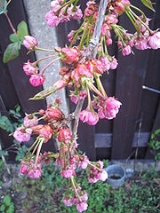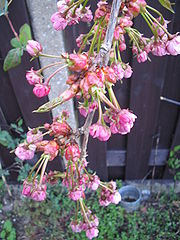
Prunus serrulata
Encyclopedia
Prunus serrulata or Japanese Cherry; also called Hill Cherry, Oriental Cherry or East Asian Cherry, is a species of cherry
native to Japan
, Korea
and China
. It is known for its spring cherry blossom displays and festivals.
tree
with a short single trunk, with a dense crown reaching a height of 8–12 m (26.2–39.4 ft). The smooth bark
is chestnut-brown, with prominent horizontal lenticel
s. The leaves
are arranged alternately, simple, ovate-lanceolate, 5–13 cm long and 2.5–6.5 cm broad, with a short petiole and a serrate or doubly serrate margin. At the end of autumn, the green leaves turn yellow, red or crimson.
Flowers
The flower
s are produced in racemose clusters of two to five together at nodes on short spurs in spring at the same time as the new leaves appear; they are white to pink, with five petals in the wild type tree. The fruit
is a globose black drupe
8–10 mm diameter.

s have been selected, many of them with double flowers with the stamens replaced by additional petals.
In cultivation in Europe and North America, it is usually grafted on to Prunus avium 'Wild Cherry' roots; the cultivated forms rarely bear fruit. It is viewed as part of the Japanese custom of Hanami
.
The National Cherry Blossom Festival
is a spring celebration in Washington, D.C.
, commemorating the 1912 gift of Prunus serrulata Japanese cherry trees from Tokyo to the city of Washington. They are planted in the Tidal Basin park.
:
Selected important cultivars include:
Prunus
Prunus is a genus of trees and shrubs, which includes the plums, cherries, peaches, apricots and almonds. There are around 430 species spread throughout the northern temperate regions of the globe. Many members of the genus are widely cultivated for fruit and ornament.-Botany:Members of the genus...
native to Japan
Japan
Japan is an island nation in East Asia. Located in the Pacific Ocean, it lies to the east of the Sea of Japan, China, North Korea, South Korea and Russia, stretching from the Sea of Okhotsk in the north to the East China Sea and Taiwan in the south...
, Korea
Korea
Korea ) is an East Asian geographic region that is currently divided into two separate sovereign states — North Korea and South Korea. Located on the Korean Peninsula, Korea is bordered by the People's Republic of China to the northwest, Russia to the northeast, and is separated from Japan to the...
and China
China
Chinese civilization may refer to:* China for more general discussion of the country.* Chinese culture* Greater China, the transnational community of ethnic Chinese.* History of China* Sinosphere, the area historically affected by Chinese culture...
. It is known for its spring cherry blossom displays and festivals.
Description
Prunus serrulata is a small deciduousDeciduous
Deciduous means "falling off at maturity" or "tending to fall off", and is typically used in reference to trees or shrubs that lose their leaves seasonally, and to the shedding of other plant structures such as petals after flowering or fruit when ripe...
tree
Tree
A tree is a perennial woody plant. It is most often defined as a woody plant that has many secondary branches supported clear of the ground on a single main stem or trunk with clear apical dominance. A minimum height specification at maturity is cited by some authors, varying from 3 m to...
with a short single trunk, with a dense crown reaching a height of 8–12 m (26.2–39.4 ft). The smooth bark
Bark
Bark is the outermost layers of stems and roots of woody plants. Plants with bark include trees, woody vines and shrubs. Bark refers to all the tissues outside of the vascular cambium and is a nontechnical term. It overlays the wood and consists of the inner bark and the outer bark. The inner...
is chestnut-brown, with prominent horizontal lenticel
Lenticel
A lenticel is an airy aggregation of cells within the structural surfaces of the stems, roots, and other parts of vascular plants. It functions as a pore, providing a medium for the direct exchange of gasses between the internal tissues and atmosphere, thereby bypassing the periderm, which would...
s. The leaves
Leaf
A leaf is an organ of a vascular plant, as defined in botanical terms, and in particular in plant morphology. Foliage is a mass noun that refers to leaves as a feature of plants....
are arranged alternately, simple, ovate-lanceolate, 5–13 cm long and 2.5–6.5 cm broad, with a short petiole and a serrate or doubly serrate margin. At the end of autumn, the green leaves turn yellow, red or crimson.
Flowers
The flower
Flower
A flower, sometimes known as a bloom or blossom, is the reproductive structure found in flowering plants . The biological function of a flower is to effect reproduction, usually by providing a mechanism for the union of sperm with eggs...
s are produced in racemose clusters of two to five together at nodes on short spurs in spring at the same time as the new leaves appear; they are white to pink, with five petals in the wild type tree. The fruit
Fruit
In broad terms, a fruit is a structure of a plant that contains its seeds.The term has different meanings dependent on context. In non-technical usage, such as food preparation, fruit normally means the fleshy seed-associated structures of certain plants that are sweet and edible in the raw state,...
is a globose black drupe
Drupe
In botany, a drupe is a fruit in which an outer fleshy part surrounds a shell of hardened endocarp with a seed inside. These fruits develop from a single carpel, and mostly from flowers with superior ovaries...
8–10 mm diameter.

Cultivation
Prunus serrulata is widely grown as a flowering ornamental tree, both in its native countries and throughout the temperate regions of the world. Numerous cultivarCultivar
A cultivar'Cultivar has two meanings as explained under Formal definition. When used in reference to a taxon, the word does not apply to an individual plant but to all those plants sharing the unique characteristics that define the cultivar. is a plant or group of plants selected for desirable...
s have been selected, many of them with double flowers with the stamens replaced by additional petals.
In cultivation in Europe and North America, it is usually grafted on to Prunus avium 'Wild Cherry' roots; the cultivated forms rarely bear fruit. It is viewed as part of the Japanese custom of Hanami
Hanami
is the Japanese traditional custom of enjoying the beauty of flowers, "flower" in this case almost always meaning cherry blossoms or ume blossoms. From the end of March to early May, sakura bloom all over Japan, and around the first of February on the island of Okinawa...
.
The National Cherry Blossom Festival
National Cherry Blossom Festival
The National Cherry Blossom Festival is a spring celebration in Washington, D.C., commemorating the March 27, 1912, gift of Japanese cherry trees from Mayor Yukio Ozaki of Tokyo to the city of Washington...
is a spring celebration in Washington, D.C.
Washington, D.C.
Washington, D.C., formally the District of Columbia and commonly referred to as Washington, "the District", or simply D.C., is the capital of the United States. On July 16, 1790, the United States Congress approved the creation of a permanent national capital as permitted by the U.S. Constitution....
, commemorating the 1912 gift of Prunus serrulata Japanese cherry trees from Tokyo to the city of Washington. They are planted in the Tidal Basin park.
Cultivars and varieties
There are several varietiesVariety (biology)
In botanical nomenclature, variety is a taxonomic rank below that of species: as such, it gets a three-part infraspecific name....
:
- Prunus serrulata var. serrulata (syn. var. spontanea). Japan, Korea, China.
- Prunus serrulata var. hupehensis (Ingram) Ingram. Central China. Not accepted as distinct by the Flora of China.
- Prunus serrulata var. lannesiana (Carrière) Makino (syn. Cerasus lannesiana Carrière; Prunus lannesiana (Carrière) E. H. Wilson). Japan.
- Prunus serrulata var. pubescens (Makino) Nakai. Korea, northeastern China.
- Prunus serrulata var. spontanea (Maxim.) E. H. Wilson (syn. Prunus jamasakura Siebold ex Koidz.)
Selected important cultivars include:
- Prunus serrulata 'Amonogawa'. Fastigate Cherry, with columnar habit; flowers semi-double, pale pink.
- Prunus serrulata 'Kwanzan'. =P. serrulata 'Sekiyama', 'Kanzan', or 'Kansan'. Kanzan Cherry. Flowers pink, double; young leaves bronze-coloured at first, becoming green.
- Prunus serrulata 'Kiku-shidare'. Cheal's Weeping Cherry. Stems weeping; flowers double, pink. Tends to be short-lived.
- Prunus serrulata 'Shirofugen'. Flowers double, deep pink at first, fading to pale pink.
- Prunus serrulata 'Shirotae'. Mt. Fuji Cherry. Very low, broad crown with nearly horizontal branching; flowers pure white, semi-double.
- Prunus serrulata 'Tai Haku'. Great White Cherry. Flowers single, white, very large (up to 8 cm diameter); young leaves bronze-coloured at first, becoming green.
- Prunus serrulata 'Ukon'.

